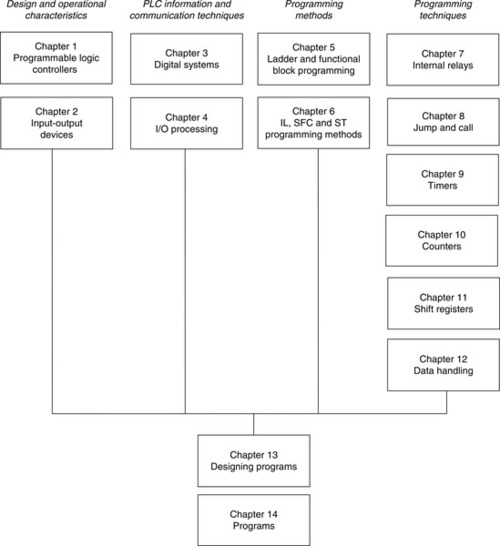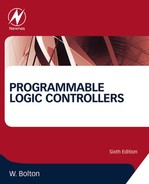Preface
Technological advances in recent years have resulted in the development of the programmable logic controller (PLC) and a consequential revolution of control engineering. This book, an introduction to PLCs, aims to ease the tasks of practicing engineers coming into contact with PLCs for the first time. It also provides a basic course for students in curricula such as the English technicians' courses for Nationals and Higher Nationals in Engineering, giving full syllabus coverage of the National and Higher National in Engineering units, company training programs, and serving as an introduction for first-year undergraduate courses in engineering.
The book addresses the problem of various programmable control manufacturers using different nomenclature and program forms by describing the principles involved and illustrating them with examples from a range of manufacturers. The text includes:
• The basic architecture of PLCs and the characteristics of commonly used input and outputs to such systems
• A discussion of the number systems: denary, binary, octal, hexadecimal, and BCD
• A painstaking methodical introduction, with many illustrations, describing how to program PLCs, whatever the manufacturer, and how to use internal relays, timers, counters, shift registers, sequencers, and data-handling facilities
• Consideration of the standards given by IEC 61131-3 and the programming methods of ladder, functional block diagram, instruction list, structured text, and sequential function chart
• Many worked examples, multiple-choice questions, and problems to assist the reader in developing the skills necessary to write programs for programmable logic controllers, with answers to all multiple-choice questions and problems given at the end of the book
Prerequisite Knowledge Assumed
This book assumes no background in computing. However, a basic knowledge of electrical and electronic principles is desirable.
Changes from the Fifth Edition
The fourth edition of this book was a complete restructuring and updating of the third edition and included a more detailed consideration of IEC 61131-3, including all the programming methods given in the standard, and the problems of safety, including a discussion of emergency stop relays and safety PLCs. The fifth edition built on this foundation by providing more explanatory text, more examples, and more problems and includes with each chapter a summary of its key points. The sixth edition has a new Chapter 1 with a comparison of relay, microprocessor and PLC controlled systems, an updated consideration of commercial PLCs, and more discussion of the merits and problems of the various PLC programming methods given by the IEC 61131 standard. Chapter 2 has had some new material on sensors included. The discussion of sequential function charts in Chapter 6 has been rewritten to give more detail of the method. In Chapter 10 the part concerned with the sequencer has been rewritten. The section of Chapter 13 concerned with forcing has been extended and Chapter 14 has had more case studies added.
Aims
This book aims to enable the reader to:
• Identify and explain the main design characteristics, internal architecture, and operating principles of programmable logic controllers.
• Use PLCs of different sizes and from different manufacturers.
• Use commonly used input and output devices with PLC systems, taking account of their characteristics.
• Explain the processing of inputs and outputs by PLCs so that input and output systems can be used correctly with PLCs.
• Use communication links involved with PLC systems, recognizing the protocols and networking methods involved.
• Use ladder programs involving internal relays, timers, counters, shift registers, sequencers, and data handling to tackle applications.
• Identify safety issues with PLC systems so they can be used safely.
• Use methods used for fault diagnosis, testing, and debugging.
Structure of the Book
The following figure outlines the structure of the book.

Acknowledgments
I am grateful to the many reviewers of the various editions of this book for their helpful feedback and comments.
